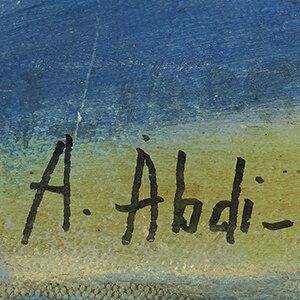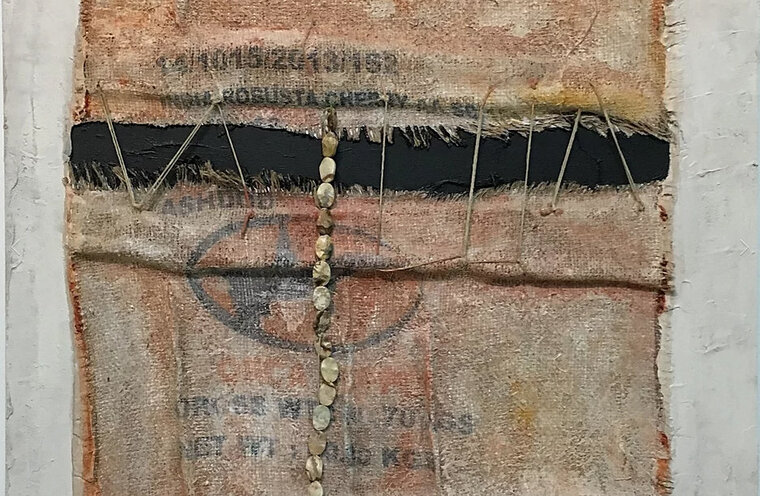


Last updated on Wed 8 March, 2017


March 8 - April 22, 2017
ABED ABDI / ASAD AZI / IBRAHIM NUBANI / MICHAEL HALAK / NASRIN ABU BAKER / SAMAH SHIHADI
Third Identity - Al Dakhel
CAP Kuwait
The majority of native Palestinians were dispersed, uprooted or exiled after the Nakba of 1948; as a result, their common history was fragmented between Al Dakhel Palestinians and the diaspora. Those who stayed–or could return home – came of age in a system where their culture and immediate past were erased. Their cultural education was further unique in the region, as it reflected the influences from western and eastern Europe of the newly emigrated people. This slowly changed after the 1970s, when the second generation started to claim their roots post-Nakba and question their unequal status in society. In parallel, artists such as Abed Abdi and Asad Azi, were working on the reconstruction of a local Palestinian collective memory. Therefore, the identity of Al Dakhel artists is suspended between citizenship, Israeli education, occidental influences, belonging to Palestinian culture and a strong attachment to their land.
Questions related to displacement, belonging, native culture and fragmentation recur in the work of Al Dakhel artists. By addressing these personal and highly specific questions within the context of a complex society, the artists touch upon more universal questions: who are we, and how does identity evolve when challenged?
THIRD IDENTITY explores the artistic (re)construction of the Al Dakhel identity and its evolution through three generations of artists. It is conceived as a journey through time that outlines common themes and concerns such as memory, post colonialism, hybridity, minority, and both the absence and cross-fertilization of cultures. It shows the richness and the diversity that flourished despite the traumas and “schizophrenic” living conditions, as one artist put it. This exhibition aims to shine a light on this group and give it its rightful place within the regional Arab culture.
ABED ABDI
Abed Abdi had been promoting Palestinian culture, intercultural exchange and peace though art for more than three decades. From the building of monuments honouring Palestinian people, to the circulation of prints depicting the life and struggle of Palestinian refugees, along with other projects, he has helped construct a new Palestinian identity in his homeland. Deeply influenced by his art education in Eastern Germany, Abdi is also one of the first artists to integrate western influences and techniques within his work. His paintings occupy the middle ground between figuration and abstraction, and reflect his political and social convictions. As he explains,
"art must be committed and play a role."
ASAD AZI
Asad Azi had also contributed to the development of Palestinian culture in many ways, including though the creating of the group REGA, or Moment. Blending cultural and historical references, media and techniques, Azi's intricate works reflect a search for his own identity, as well as that of his community. Azi continued where Picasso and Matisse left art. While Matisse embraced the East and Picasso the South (Africa), Azi chose to expand the range of humanity by allying the West to his own culture. The line and shape has meeting. In his intricate, richly coloured and multi-layered works, Azi investigates the mundane and the dramatic, the secular and the sacred. Using traces from the past, like photographs and objects, the artist reveals the forgotten history of people and places.
IBRAHIM NUBANI
Nubani was a student of Abed Abdi. Having endured te constant constraints of Israeli control from 1948 onward, Nubani suffered from and identity crisis and was ultimately diagnosed with schizophrenia in 1988, during the First Intifada. Nubani moved to Jenin during the Second Intifada and survived the Israeli occupation forces' invasion and destruction of the Jenin refugee camp. The Jenin experience seared him in particular, and deeply affected his art. He poignantly puts it: "I am a refugee in my own homeland"
MICHAEL HALAK
Halak represents the second generation of artists, those born after 1967. In the footsteps of the Western tradition of realist and illusory painting that goes back hundreds of years, Halak's earlier works focus on classical subjects such as portraits, landscapes and still lives, with a contemporary twist. The illusion of reality as he represents it on canvas may be perfect, yet it carries a disturbing charge related to to states of disruption and disintegration.
NASRIN ABU BAKER
Abu Baker represents a growing segment of the Al Dakhel artist community: like the new generation of artists, she works across media, from video, installations, to painting. She combines poetry, subtlety, rebellion and feminism in a unique way to address major themes: the status of the Palestinian citizen living in Israel, and he position of women in Arab societies. She frequently mixes cultural symbols, as well as Middle Eastern and Western influences to make her point: what is at stake in her works are universal issues and imbalances.
SAMAH SHIHADI
Shihadi represents the third generation in this exhibition. With pencil and charcoal, she addresses the daily personal and social challenges that women face, at home and beyond. Her exceptional drawing skills reach another level of precision, subtlety and emotion.
Join us in our endless discovery of modern and contemporary Arab art